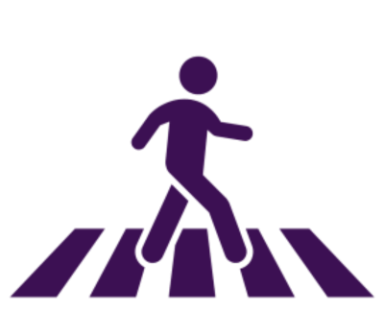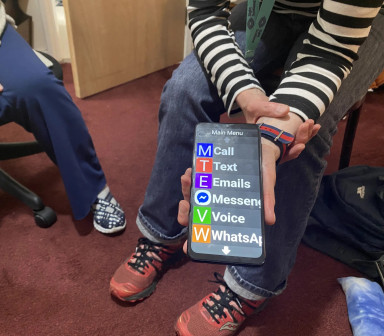In our latest blog, Sight Scotland Veterans Rehabilitation Officer Mick Hilton shares five key things to know about sighted guiding for people with sight loss or a visual impairment.

Assistance isn't always required - or welcomed.
Don’t assume someone with a visual impairment requires sighted guide help. Before doing anything, introduce yourself and ask if the person requires your support, then wait until it’s accepted. Do not make physical contact at introduction, as this can startle someone. Listen or ask for instructions on how best to assist the person. They may just be trying to work out where they are and may not want help, but don’t be scared to ask and don’t be offended if declined.

Don't link arms
If sighted guide support is required, ask which arm they would like to take, as people usually have a preference. With a light touch to their arm, offer your guiding arm.
The visually impaired person should use a “pincer grip” just above your elbow, keep your guiding arm tight against your body, and ensure grip is maintained throughout the guiding session.
We discourage linking arms for several reasons, but mainly because if one person stumbles or falls with pincer grip the contact is easily broken, avoiding both people falling.

Talk to them
Clear verbal communication is very important.
For example, saying “there are stairs ahead” probably isn't very helpful for them. Instead, say something like, “we are approaching stairs going up, with a handrail on the left”.
Immediately, the visually impaired person knows if they are ascending or descending and what side the handrail is on for extra support. You can also count down to when they'll encounter the stairs.
When they are ascending or descending remember to advise them when they are on the last step so they know when the stairs will end.

Move at their pace
Ensure you move at the pace of the person you are guiding.
Don’t force them to try and match your pace, they have control of the pace and with their grip you should feel if they are pushing you on or holding you back.
If in doubt, you can always ask if they are comfortable with the pace you're going.

Give space to manoeuvre
When going through a narrow gap, tell the person you are guiding and move your guiding hand to your back. The person will naturally follow this, and move in behind you. This is advisable when moving through doorways.
For road crossings, let the visually impaired person find the kerb edge with their feet first, advise them as you “step down”, and at their own pace the visually impaired person will follow.
Wait until they have stepped down before moving off. Remember to advise “stepping up” when at the other side of the road also.

Describe seating
When approaching a seat, give a description telling the person you are guiding if the chair:
- has arms;
- has a high back;
- is on wheels; or
- swivels or moves.
Place your non-guiding hand on the back of the chair or onto the seat pad and have the person you are guiding run their hand down the arm to locate the chair. This way they know exactly where and what type of seat they are using and they have control of sitting down.
Never force them into the seat or stop them from seating themselves unless they specifically ask.
Visual Impairment Training
Our teams at Sight Scotland take part in Vision Impairment Awareness training which includes hands-on experience with guiding techniques and practical exercises to better understand the challenges faced by people with sight loss.
Watch our video of one of our training sessions here; you'll be able to see some of the guiding techniques yourself which start from 00:56 in the video.

